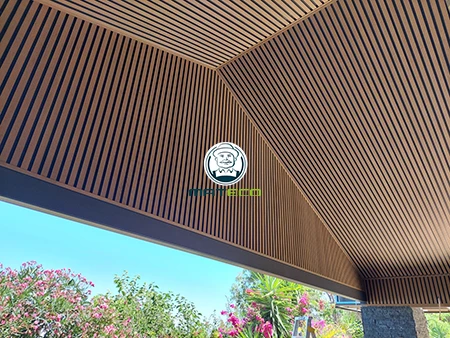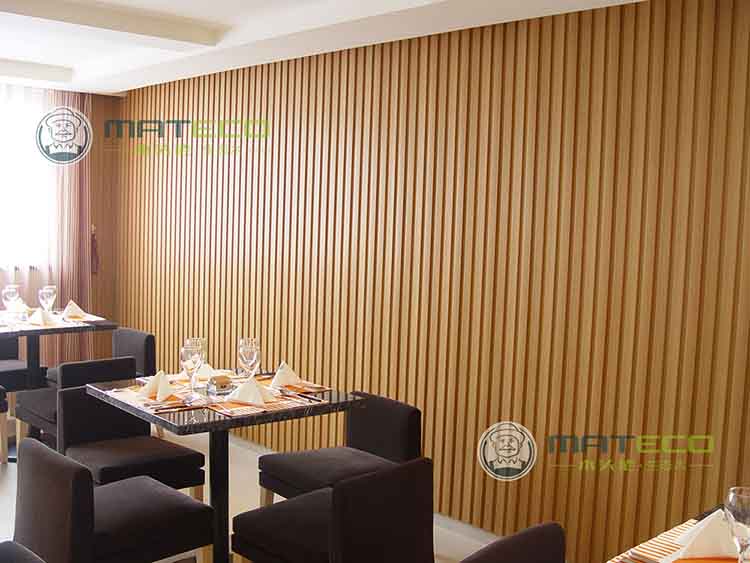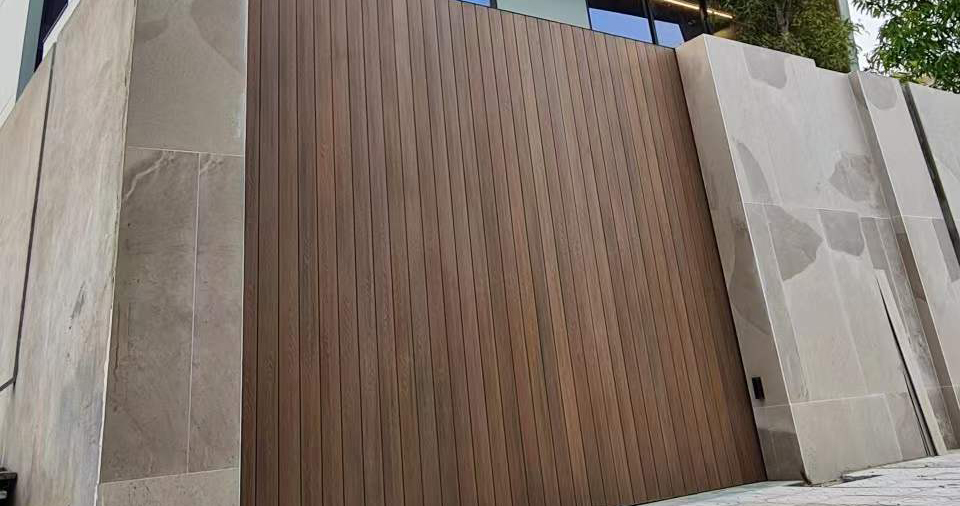What is Fluted Wall Cladding?
WPC, or Wood Plastic Composite, is a unique blend of wood fibers and plastic materials. When we talk about fluted wall cladding, we're referring to a specific design pattern characterized by vertical grooves or ridges. Now, combine these two, and you get WPC fluted wall cladding: a durable, versatile, and aesthetically pleasing solution for building exteriors. It's gaining momentum in the B2B sector for its combined benefits of both wood and plastic, offering a natural appearance with the robustness of modern materials.

WPC fluted wall cladding
The Rise in Popularity of WPC Materials: A Historical Perspective
1) The Early Days of WPC: An Ingenious Solution
The concept of blending wood fibers with plastic isn't entirely new. In fact, the initial experiments with these blended materials can be traced back to the early 20th century. The goal was clear: to harness the best attributes of both wood and plastic. Wood, with its natural charm and texture, was an obvious choice for many constructions. However, its susceptibility to moisture, termites, and rot made it less than ideal for long-term durability. On the other hand, plastics, while incredibly durable, lacked the organic allure and tactile warmth of wood.
Enter WPC. By combining the two, innovators aimed to craft a material that retained the aesthetic appeal of wood while enjoying the resilience of plastic. But the journey wasn't without challenges.
2) Overcoming Hurdles: Perfecting the WPC Blend
While the idea of WPC was groundbreaking, early iterations were far from perfect. There were issues with consistency, stability, and sometimes even with appearance, making it look more plastic than wood. Through the mid-20th century, extensive research went into refining the blend, ensuring that the wood fibers were encapsulated perfectly by the plastic, thus preventing any moisture-related issues.
3) The Green Movement: WPC's Time to Shine
As the world pivoted towards sustainable and eco-friendly solutions in the latter half of the 20th century and early 21st century, WPC began to see a surge in its popularity. The realization that WPC could be produced using recycled plastic and wood waste gave it a significant edge in an increasingly eco-conscious market. This wasn't just a material that looked good and lasted long; it was also a nod to our planet, a choice that minimized waste and reduced the need for virgin resources.
4) Modern-Day WPC: A B2B Favorite
Fast forward to today, and WPC has firmly established itself in the B2B sector, particularly in construction and design. The reasons are manifold: durability, aesthetics, and sustainability, as mentioned earlier. But there's also a growing appreciation for materials that can withstand the test of time, that require minimal maintenance, and that can offer the flexibility of design. WPC, with its modern iterations, ticks all these boxes.

WPC fluted wall cladding for ceiling
Why Businesses Choose WPC Fluted Wall Cladding
1) The Unwavering Durability Factor
Any business that invests in infrastructure values durability. Enter WPC fluted wall cladding. One of the standout features of WPC (Wood Plastic Composite) is its robust nature. Unlike traditional wood, which can rot, or metals that might rust, WPC stands strong against the elements. Its inherent resistance to moisture, UV rays, and even pests like termites makes it an excellent choice for exterior applications. In essence, businesses are investing in a material that not only looks good upon installation but maintains its integrity for years to come.
2) Low Maintenance, High Appeal
Maintenance can be both time-consuming and expensive, especially when it comes to building exteriors. This is where WPC fluted wall cladding truly shines. Unlike other materials that might need frequent painting, sealing, or treatment to keep them in prime condition, WPC asks for minimal fuss. A simple washdown every now and then is usually enough to keep it looking as good as new. For businesses, this translates to fewer maintenance costs and a consistently appealing facade – a win-win situation.
3) The Green Advantage: Sustainability Matters
With the growing emphasis on sustainable business practices, the eco-friendliness of WPC can't be overstated. Some of this cladding material could be recycled. Businesses aren't just choosing a material based on aesthetics and durability; they're making an environmentally responsible choice. In today's market, where consumers and partners often align with eco-conscious brands, this benefit of WPC fluted wall cladding becomes a compelling selling point.
4) Stylish Modern Aesthetics: Beyond Functionality
Beyond all the practical benefits, there's an undeniable aesthetic advantage to WPC fluted wall cladding. The fluted design, characterized by its vertical grooves, imparts a contemporary and sleek look to buildings. It's a design that can make structures stand out, exuding a sense of modernity and style. Businesses understand the value of first impressions, and with WPC fluted wall cladding, they’re ensuring their infrastructure mirrors the forward-thinking nature of their operations.

WPC fluted wall panel for restaurant
WPC Fluted Wall Cladding vs. Traditional Cladding
1) A Glimpse at Traditional Cladding
Before we dive into the comparison, it's essential to understand what traditional cladding entails. Traditional cladding materials often include brick, stone, timber, and metal. These have been used for centuries, providing buildings with protection and aesthetic appeal. Each has its unique set of advantages, from the timeless look of brick to the natural warmth of timber.
2) Durability: A Battle Against the Elements
When it comes to enduring the test of time and weather, WPC fluted wall cladding has a significant edge. While traditional wood cladding can warp, rot, or get infested by pests over time, WPC's composite nature ensures resistance against these common issues. Metal cladding, on the other hand, can be prone to rust, especially in damp environments. In contrast, WPC remains unaffected by moisture, giving it a longevity that's hard to rival.
3) Maintenance: Keeping Up Appearances
One of the undeniable benefits of WPC is its low-maintenance nature. Traditional timber cladding might require periodic treatments, sealing, or painting to retain its look and structural integrity. Brick and stone, while robust, might need cleaning or repointing to combat the effects of time. WPC fluted wall cladding simplifies this process. A casual clean is generally all it needs, saving businesses time, effort, and money in the long run.
4) Eco-Friendliness: The Green Quotient
While traditional materials like brick and stone are naturally sourced, the process of obtaining and manufacturing them can be resource-intensive. WPC fluted wall cladding, crafted predominantly from recycled materials, offers a more sustainable alternative. Its production leaves a smaller carbon footprint, and its long lifespan ensures reduced waste, making it a choice in tune with modern environmental sensibilities.
5) Aesthetics: Modern vs. Timeless
Aesthetically, both WPC and traditional cladding have their merits. While the fluted design of WPC wall cladding provides buildings with a contemporary, sleek appearance, traditional claddings like brick or stone convey a sense of timelessness and solidity. The choice here often boils down to the desired look and feel a business wants for its structure. However, it's worth noting that WPC offers design versatility, allowing for a range of finishes and appearances.
6) The Bottom Line
While traditional cladding methods have served buildings well for years and have their own set of merits, WPC fluted wall cladding presents a compelling case, especially for modern businesses. Balancing aesthetics, durability, maintenance ease, and eco-friendliness, WPC is proving to be more than just a trend – it's a testament to the evolution of building materials in response to changing needs and values.
The Projected Growth of WPC in B2B
Given the current trends and the increasing global focus on sustainability, the future looks promising for WPC in the B2B sector. Industry forecasts suggest steady growth for WPC products over the next decade, with Asia-Pacific and North America leading the demand. As urbanization continues to surge and more businesses prioritize long-lasting, low-maintenance, and green materials, WPC's market share is expected to expand. Furthermore, as new applications for WPC are discovered and refined, its footprint in the B2B sector will likely become even more significant.
If you are looking for a WPC manufacturer, MATECO WPC will be your best choice.
Website: https://www.matecowpc.com
WhatsApp: +86-13380085620
Email: info@matecowpc.com
















